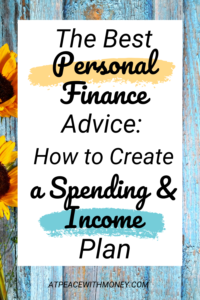
Welcome back to our series on creating a spending and income plan! This is part two, you can read part one right here. So far we have gotten clear on how much we’re spending and where the money is going, and we’ve also figured out about how much income we’re bringing in. Today, let’s get deeper into the process:
Create Your Plan
Now that you have a clear understanding of your income and expenses, it’s time to put together a plan. There are all kinds of ways to set up a spending plan. My mentor Karen McCall advocates for creating very specific categories.
In Financial Recovery, she lists categories like home, food, gifts, and business/project expenses, but she also lists categories like spiritual growth and self-care, to get you thinking about prioritizing these in both your spending and your life. With information from the previous step and some careful planning, you can create categories and estimate what your spending will be for each during the month ahead.
Another approach that I sometimes use with people who are very focused on saving, is a set amount for flexible expenses. This method lumps all expenses that aren’t your fixed necessities (rent/mortgage, etc.) and gives you an amount of money to work with for all of them. I don’t necessarily recommend this as a long-term solution, but it can work when you’re getting started or have a savings goal to meet.
Analyze Your Plan
With a basic plan in place, now is the time to take a look at your estimated income and make sure your plan will work for you. If there’s a shortfall, it’s time to make adjustments.
Consider how you can alter your spending. How can you cull your spending and lower your expenses while still getting your needs met? At this step it can be valuable to reflect on your values and distinguish your needs from your wants.
Similarly, at this stage you can ask yourself if it is possible to increase your income to cover the shortfall. This is something worth brainstorming about!

Stick to Your Plan
Once you have created your and feel certain it will work for the month ahead, put it into action! The best way to do this is by staying in touch with your money and making sure you’re staying on track.
I highly recommend beginning to do a weekly money check-in if you don’t already. Just 30 minutes out of your week can make a huge difference and help you stick to your carefully-crafted plan. Check out my article 3 Things to Look For During Your Weekly Money Check-In for ideas on how to stay on top of your money.
Karen McCall also recommends doing a month-end review. During this step, you compare the spending plan you started with at the beginning of the month, to your actual spending during the entire month. Karen writes, “Comparing your planned to your actual spending and earning helps you gain clarity about how the spending-plan process works. This is an opportunity to get to know yourself better and to gain skills that will help you create your spending plans even more effectively.”
The process outlined here is one that can be done solo or with an accountability partner. I love to work with clients through this process, and encourage you to reach out if you would like to work together!






